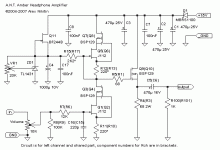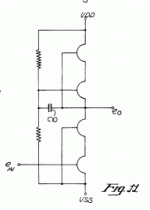As I plan to release an updated version soon, here is a complete circuit of my SE Class A and "zero negative feedback" headphone amplifier design from 2004, using my idea I've published here:
http://www.diyaudio.com/forums/showthread.php?s=&threadid=48500
It works well with most medium to high impedance headphones (from 60 to 600 Ohm). For low impedance headphones the output FET could be replaced by a device with a higher transconductance at 100 mA.
This circuit and a short description also now available as a PDF file on my website here: http://www.ant-audio.co.uk /Theory/ANT Amber Headphone Amplifier.pdf . As usual - free for a private builder, not for production. If somebody would like to build a copy, I would be happy to explain in this thread how to select the FETs for it and what replacement parts could be used.
Enjoy!
Alex
http://www.diyaudio.com/forums/showthread.php?s=&threadid=48500
It works well with most medium to high impedance headphones (from 60 to 600 Ohm). For low impedance headphones the output FET could be replaced by a device with a higher transconductance at 100 mA.
This circuit and a short description also now available as a PDF file on my website here: http://www.ant-audio.co.uk /Theory/ANT Amber Headphone Amplifier.pdf . As usual - free for a private builder, not for production. If somebody would like to build a copy, I would be happy to explain in this thread how to select the FETs for it and what replacement parts could be used.
Enjoy!
Alex
Attachments
Re: Re: My A.N.T. "Amber" headphone amplifier
First of all, Dimitri, I did not "borrow" anybody's ideas. If I know about the previous work I would always mention it. However in this particular case I can see no relevance to my circuit at all, except some similarity in configuration. There is no capacitor in my circuit . Q5 and Q7 in my circuit only provide for a current source load, temperature compensated to match the amplifing pair below. And the cascoded combination of two FETs was known well before 1985 and described in "The Art of Electronics".
. Q5 and Q7 in my circuit only provide for a current source load, temperature compensated to match the amplifing pair below. And the cascoded combination of two FETs was known well before 1985 and described in "The Art of Electronics".
Secondly, I really don't like your tone. Sorry.
Alex
dimitri said:Hello Alex,
Glad to see one more implementation of Richard Knapp (Spatial Audio) patents, dated 1985 and earlier. Probably it will be nice to show some appreciation while "borrowing" his ideas.
First of all, Dimitri, I did not "borrow" anybody's ideas. If I know about the previous work I would always mention it. However in this particular case I can see no relevance to my circuit at all, except some similarity in configuration. There is no capacitor in my circuit
Secondly, I really don't like your tone. Sorry.
Alex
Tim__x said:A quick google shows that it not a NatSemi invention, but dates back to tubes, and is certainly older than any patent from the 80's.
Yes, the "mu-follower" is well known for the tube circuits and there is a certain connection between that and the circuit Dimitri posted. However, as I've pointed out already, my circuit has nothing to do with either of these
Cheers
Alex
I never meant to imply your cicruit was "borrowed".
Just an off-topic comment on the patented circuit mentioned not being very original.
I see yours as nothing more than a cascode (not that there's anything wrong with 'just a cascode').
At this point, there are very few functional arrangments of three terminal devices that have not been done before.
Just an off-topic comment on the patented circuit mentioned not being very original.
I see yours as nothing more than a cascode (not that there's anything wrong with 'just a cascode').
At this point, there are very few functional arrangments of three terminal devices that have not been done before.
Tim__x said:At this point, there are very few functional arrangments of three terminal devices that have not been done before.
True
Cheers
Alex
- Status
- This old topic is closed. If you want to reopen this topic, contact a moderator using the "Report Post" button.
- Home
- Amplifiers
- Headphone Systems
- My A.N.T. "Amber" headphone amplifier

